Matthew S. Williams's Blog, page 40
August 10, 2014
The Future is Here: Shipbuilder Robotic Exosuit
 With numerous prototypes in development, it seems like just a matter of time before the industrial robotic exoskeleton becomes an everyday reality. Between NASA, the US armed forces, Panasonic, and now Daewoo, the range of powered robot suits seems virtually limitless. And Daewoo, the South-Korean manufacturing giant, now appears to be a step ahead of the competition, having already tested its prototype suits last year.
With numerous prototypes in development, it seems like just a matter of time before the industrial robotic exoskeleton becomes an everyday reality. Between NASA, the US armed forces, Panasonic, and now Daewoo, the range of powered robot suits seems virtually limitless. And Daewoo, the South-Korean manufacturing giant, now appears to be a step ahead of the competition, having already tested its prototype suits last year.
The test took place at a sprawling shipyard in Okpo-dong in South Korea, where workers dressed in wearable robotics were hefting large hunks of metal, pipes and other objects. It was all part of a test by Daewoo’s Shipbuilding and Marine Engineering facility, where workers strapped into 28kg (62 pound) aluminum alloy, steel and carbon fiber suits called the RoboShipbuilder that supported their own weight plus an additional 30kg (66 pounds).
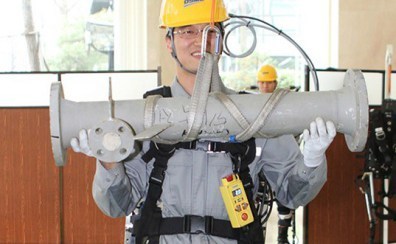 Anyone between 160 and 185cm tall (5 feet 2 inches and 6 feet) fits the suit, and it has three hours of battery life. Straps across the legs, feet and chest secure the wearer, and the RoboShipbuilder runs on hydraulic joints and electric motors, with the power source tucked inside a backpack. And, because the suit bears most of the weight of the heavy objects, wearers have much finer control over what they are handling.
Anyone between 160 and 185cm tall (5 feet 2 inches and 6 feet) fits the suit, and it has three hours of battery life. Straps across the legs, feet and chest secure the wearer, and the RoboShipbuilder runs on hydraulic joints and electric motors, with the power source tucked inside a backpack. And, because the suit bears most of the weight of the heavy objects, wearers have much finer control over what they are handling.
Gilwhoan Chu, the lead engineer for the firm’s research and development arm, says the pilot showed that the exoskeleton does help workers perform their tasks. Worker feedback was mostly positive, but their were comments that the suit could be faster and be bale to carry more weight. Chu and his team are working towards this, hoping to increase the robot’s lift capacity to 100 kilograms (220 pounds).
 The prototypes still have several important kinks to be worked out as well. In tests, workers had a hard time negotiating sloping or slippery surfaces. And the prototypes cannot yet cope with twisting motions, so workers making turns while carrying heavy objects could tire out easily. But South Korea’s vast shipbuilding market is committed to merging human oversight with automation, and Daewoo is hardly alone in working towards this goal.
The prototypes still have several important kinks to be worked out as well. In tests, workers had a hard time negotiating sloping or slippery surfaces. And the prototypes cannot yet cope with twisting motions, so workers making turns while carrying heavy objects could tire out easily. But South Korea’s vast shipbuilding market is committed to merging human oversight with automation, and Daewoo is hardly alone in working towards this goal.
Earlier this year, the Panasonic subsidiary Activelink is developing an exosuit known as the Powered Loader – a deliberate homage to the Caterpillar P-5000 Powered Work Loader from Aliens fame. According to Activelink, the Power Loader will enable a human to lift up to 100 kilos (220 pounds) and run at speeds up to 8 kilometers (5 miles) per hour, and will be powered by lithium ion battery packs that will provide several hours worth of power.
 The exoskeleton will initially be deployed in construction work, nuclear power plants, and emergency situations, but the company has big plans for the future. Activelink would like to develop an exosuit that can fit under a spacesuit or diving gear for underwater and space exploration purposes. The Power Loader appears to be a full-body version of creations like the battery-powered robotic Titan Arm, which won the 2013 James Dyson Award.
The exoskeleton will initially be deployed in construction work, nuclear power plants, and emergency situations, but the company has big plans for the future. Activelink would like to develop an exosuit that can fit under a spacesuit or diving gear for underwater and space exploration purposes. The Power Loader appears to be a full-body version of creations like the battery-powered robotic Titan Arm, which won the 2013 James Dyson Award.
The Titan Arm augments arm strength by 18 kg (40 pounds), helping rehabilitate people with back injuries and assisting those lifting objects as part of their daily work. The price for Panasonic’s strength suit is currently projected to be 500,000 yen (around $4,940), and Panasonic says it wants to bring the suits to market by next year. It’s an exciting time to be alive, where a once-feverish dream of science fiction fanatics is fast becoming reality!
And who knows? By the 2020’s, we might even be seeing something along the lines of this in active service:

“Get away from her you bitch!”
And be sure to watch this video of the Power Loader exoskeleton being tested:
Sources: newscientist.com, cnet.com, (2), jamesdysonfoundation.com


August 9, 2014
The Future is Here: Autonomos Mineroller Vehicles
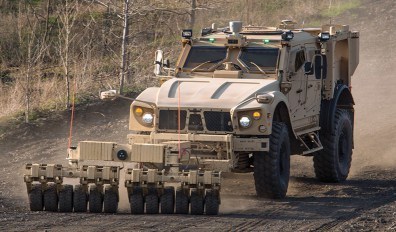 Improvised explosive devices (IEDs), landmines and other kinds of roadside bombs are a major threat to Coalition troops serving overseas. And even though combat operations in Afghanistan are coming to a close in the near future, military planners and developers are still looking for ways to address the kinds of threats that are all too common in these fields of engagement.
Improvised explosive devices (IEDs), landmines and other kinds of roadside bombs are a major threat to Coalition troops serving overseas. And even though combat operations in Afghanistan are coming to a close in the near future, military planners and developers are still looking for ways to address the kinds of threats that are all too common in these fields of engagement.
One such developer is U.S. defense contractor Oshkosh Defense, which recently unveiled its new M-ATV, an armored vehicle specially designed to resist blasts from IEDs and mines. This specialized, high-tech troop transport detects explosives using special ground penetrating radar and a 12-wheeled mineroller which attaches to the front. But now, the company is going a step further.
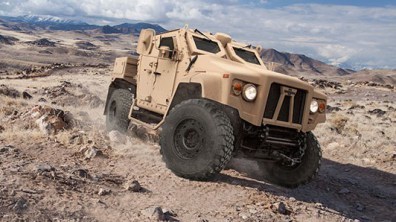 Oshkosh now claims it wants to move soldiers even further from the danger zone by putting them in another vehicle entirely and making the minesweeping truck drive itself. For the past decade, the company has been developing an autonomous driving technology called TerraMax. This self-driving system can be applied to vehicles already on the road, and was unveiled during the 2004 DARPA Grand Challenge.
Oshkosh now claims it wants to move soldiers even further from the danger zone by putting them in another vehicle entirely and making the minesweeping truck drive itself. For the past decade, the company has been developing an autonomous driving technology called TerraMax. This self-driving system can be applied to vehicles already on the road, and was unveiled during the 2004 DARPA Grand Challenge.
It’s now equipped with radar and LIDAR, which uses lasers to detect nearby objects, along with a drive-by-wire system that electronically controls engine speed, transmission, braking, and steering. The system does more than steer and hit the throttle and brakes. It can intelligently control a central tire inflation system and driveline locks to navigate deep sand or mud, all without any input from the operator.
 Similar to the technology that powers Google’s self-driving cars, TerraMax is adapted for use in much tougher conditions. But whereas Google and big auto manufacturers can carefully map roads, lane markings, and speed limit signs before its vehicles are even on the road, Oshkosh doesn’t have those advantages. It’s vehicles must navigate hostile terrain in territories that have not been thoroughly mapped and imaged.
Similar to the technology that powers Google’s self-driving cars, TerraMax is adapted for use in much tougher conditions. But whereas Google and big auto manufacturers can carefully map roads, lane markings, and speed limit signs before its vehicles are even on the road, Oshkosh doesn’t have those advantages. It’s vehicles must navigate hostile terrain in territories that have not been thoroughly mapped and imaged.
So it made TerraMax capable of combining overhead imagery from satellites and planes with standard military maps generated through geographic information systems. That lets soldiers define roads and other obstacles, much like with a commercial GPS system. Once given a defined course, the vehicles can navigate themselves while operators set things like vehicle speed and following distance.
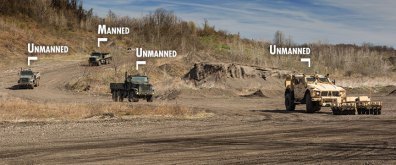 Granted, these aren’t entirely autonomous vehicles. Whenever a convoy reaches an impasse of some kind, the M-ATV will need to alert an operator and ask what to do. However, it is still an impressive system that achieves two key objectives. One, it allows the military to move more cargo with fewer personnel; and two, it makes a convoy look like it’s carrying more personnel than it really is, which is likely to deter attacks.
Granted, these aren’t entirely autonomous vehicles. Whenever a convoy reaches an impasse of some kind, the M-ATV will need to alert an operator and ask what to do. However, it is still an impressive system that achieves two key objectives. One, it allows the military to move more cargo with fewer personnel; and two, it makes a convoy look like it’s carrying more personnel than it really is, which is likely to deter attacks.
Oshkosh’s unmanned vehicle technology is still in testing, but the company has spent the last three years working with the Marine Corp Warfighting Lab and the Office of Naval Research to get it ready for the battlefield. And while the technology is currently being developed for combat vehicles, it could also be used in civilian settings – like autonomous snow clearing at airports or police bomb disposal units.
 Though Coaltion forces are drawing down their presence in Afghanistan, Oshkosh’s and other unmanned ground vehicle concepts will likely be used in conflicts around the world in the years to come. Company representatives gave demonstrations of the technology at Eurosatory 2014, a defense industry trade show, and say they received positive feedback from other nations as well.
Though Coaltion forces are drawing down their presence in Afghanistan, Oshkosh’s and other unmanned ground vehicle concepts will likely be used in conflicts around the world in the years to come. Company representatives gave demonstrations of the technology at Eurosatory 2014, a defense industry trade show, and say they received positive feedback from other nations as well.
And it is only one of several military-grade autonomous technology project currently in development. Lockheed Martin is also working on the Autonomous Mobility Appliqué System (AMAS), which also allows for autonomous or semi-autonomous driving. With the development of unmanned systems showing no signs of slowing down, autonomous-vehicle technology is likely to advance considerably in the coming years.
And be sure to check out this video of Oshkosh showcasing the M-ATV and TerraMax system at Eurosatory 2014:
Sources: wired.com, oshkoshdefense.com, humanisticrobotics.com


August 8, 2014
Walking Dead: “They’re f***ing with the wrong people”
 Few people who watch The Walking Dead can forget how Season Four ended. After finally finding their way to Terminus and regrouping, Rick and the others quickly learned that something wasn’t right. After attempting to escape, they found themselves being herded by bullets to a railcar, which they were then told to board. Inside, they found the rest of their companions and realized the community was nothing but a lie.
Few people who watch The Walking Dead can forget how Season Four ended. After finally finding their way to Terminus and regrouping, Rick and the others quickly learned that something wasn’t right. After attempting to escape, they found themselves being herded by bullets to a railcar, which they were then told to board. Inside, they found the rest of their companions and realized the community was nothing but a lie.
A series of hints were given as to what was going on there, like the room filled with candles, the names of people written on the floor, and the slogan: “Never Again. Never Trust. We First, Always” written on the walls. The smart money says this community is made up of cannibals, based on material taken from Volume 11: Fear the Hunters. This would make sense, given their efforts to lure people in and the fact that they didn’t kill Rick and the others right away.
 In any case, the season ended with their crew reunited in crisis and Rick uttering the chilling pronouncement: “They are gonna feel pretty stupid when they find out… They screwed with the wrong people.” As it turns out, AMC had a different ending in mind. Once again, mirroring what was written in Volume 11 of the original comics, the real conversation between Rick and Abraham was punctuated with some F-bombs.
In any case, the season ended with their crew reunited in crisis and Rick uttering the chilling pronouncement: “They are gonna feel pretty stupid when they find out… They screwed with the wrong people.” As it turns out, AMC had a different ending in mind. Once again, mirroring what was written in Volume 11 of the original comics, the real conversation between Rick and Abraham was punctuated with some F-bombs.
AMC filmed this ending first, but decided to tone it down for the sake of their viewing audience. To which I have to ask… really AMC? You have a series that showcases rotting corpses eating people alive; but swearing, that’s wrong? You’re season finale was especially bloody, featuring men attempting to rape Michonne and Carl, Rick biting a man’s jugular, an evisceration, and even strong hints of cannibalism.
 In that same season, you had people bleeding out of their eye sockets, the Governor cutting off Hershel’s head, and a massive prison assault where multiple characters were violently gunned down. You even had one episode where a little girl murdered her sister and had to be executed, and where partially-cooked zombies had their heads explode once they were shot. And yet, you think the word “fuck” is a step too far? REALLY AMC???
In that same season, you had people bleeding out of their eye sockets, the Governor cutting off Hershel’s head, and a massive prison assault where multiple characters were violently gunned down. You even had one episode where a little girl murdered her sister and had to be executed, and where partially-cooked zombies had their heads explode once they were shot. And yet, you think the word “fuck” is a step too far? REALLY AMC???
Anyhoo, Season Five kicks off October 12th, by which time all questions regarding the true nature of Terminus, and why they choose to keep their captives alive, will be answered. And in the meantime, check out the clip of Rick delivering his final line as he was meant to, F-bomb and all:


Oscar Mike – Chapter Four
Success depends upon previous preparation, and without such preparation there is sure to be failure.
-Confucius
In the distance, the thunderous roar of jet engines could be heard. Their loud shrieks announced that they were flying into the morning sky, soon to descend on their target area and begin softening it up. While they waited for the noise to die down and the briefing to begin, Dezba looked around at all the familiar faces of 1st Platoon. This included Rickson of 2nd Squad, Tate of 3rd, and Saunders standing in for 5th.
Dezba looked to her last and nodded, receiving a smile in turn. Enough time had passed that he knew how to read her expressions. And at that moment, he could tell they were both feeling the same about their current situation. Once more unto the breach, their platoon leading Bravo Company’s charge. But without their CO to lead them.
He also Grayson standing behind Rollins, still the NCO of 4th and still the one making sure that the man who wore the silver bars had everything he needed to get the job done. A good platoon sergeant he was, at no point showing the slightest sign that he was pissed or worried over the shuffle that had taken place.
Perhaps he had the right of it. Dezba knew that whatever misgivings he had right now, there really was nothing that could be done about it. The new Lieutenant was about to be tested, that was certain. But he also knew the rest of them were going to be closely scrutinized as well. Haynes was never one to forget or forgive so easily. And from the top down, just about everyone in the platoon had pissed him off at this point.
Nothing left to do now but do their jobs and hope it all worked out. Maybe they’d get lucky and stay under the radar for this op.
Rollins waited for the noise of the the jets to die down a little more and quickly got to talking.
“Alright, people, listen up because we only got enough time to go over this once. Last night, aerial reconnaissance did another fly over the communities that sit to the south-east of town. Word is, they didn’t notice any sign of civilians, and we know for a fact that they haven’t been using their mobile transmitters for about a week. Command now believes they’ve been compromised, and we’re to proceed accordingly.”
Tate raised his fist. “Sir, does that mean we’re knocking over Sombrillo before hitting Espanola?”
“Negative, Sergeant. Our orders remain the same, confirm the presence of Whiskeys in or around the compound, then clear the front door. The Brigade Combat Team will still be rolling through to sanitize the place once we’ve determined the status of the community. A reminder, those heavy tanks that will be leading the charge will be shooting M1028 canister rounds almost exclusively. Those things can turn an entire horde into pulp, but aren’t exactly known for precision shooting. So we better be sure about the status of those houses. We roll in, we check it out, then we let the heavies do their thing.”
He looked around to see if anyone had any more questions so far. Satisfied, he moved on. “In terms of air support, the 150th is sending a few Spectres our way. They’ll be on station just as soon as we find our way into the town proper. Any spots not currently painted as hostile territory will still be intact, which means we will have the option of blasting them. But I don’t think I need to tell anyone that at that point, confirming the presence of civilians will once again be our priority. Captain Garcia and everyone above him were clear about not wanting any civilians dead. Not by our hands.”
Everyone assembled nodded and grunted an affirmative. Rollins looked around for any more questions. Dezba raised his arm.
“Sir, is the ammo provision still in effect for small arms?”
Rollins looked the slightest bit uncomfortable and cleared his throat before answering. “Yes, Sergeant. The Captain stressed that all grunts are to make sure their bayonets are fixed before we go in. If we can avoid wasting bullets on the undead if and when they get in close, so much the better. And the same holds true for air and heavy tank support. As the current ROE goes, if it is believed that we can take an objective without covering fire, we are to do so.”
“And who’s call is that, sir?” asked Saunders. Rollins looked at her, his discomfort giving way to visible annoyance.
“Mine, Sergeant. And I’ll be with you all every step of the way. So if you’re not sure, you run it by me first.”
Dezba looked to Saunders, noted the same look of annoyance forming on her face. He wanted to say something, intervene with some sound advice of how she shouldn’t be poking the bear. But it just wasn’t possible to get the shit back in the horse at this point. He chose instead to distract Rollins with another question.
“Sir, just how many survivors are we expecting to find inside the town?”
Rollins looked back to him and didn’t seem too surprised by the question. “Well, that’s the good news, Sergeant. The same aerial reconnaissance that declared Sombrillo and the other settlements dead claimed they saw signs of people being dug in on the east and west banks. Which means the horde didn’t get em all.”
Dezba nodded. “That is good news, sir.”
Rollins smiled mildly. “If there’s nothing else, then…” he nodded to Grayson, who immediately started barking orders.
“Alright, get to your Victors and ready your squads. We are wheels up in ten mikes!”
They immediately dispersed, each squad leader heading off to their vehicle. Dezba was sure to stall long enough to get behind Saunders and follow her a few steps. He waited til Rollins and Grayson were out of earshot too, and sidled up next to her.
“Sergeant,” he said, announcing himself.
“Sneaky,” she said, with a roll of the eyes. “Aren’t you supposed to be reporting to your Victor?”
“Yeah, but… I kind of wanted to ask you something before we shipped off.”
“Oh yeah, what’s that?”
He stopped her and turned to face her head on. He could instantly tell from the look in her eyes that she wasn’t too happy to be talking right now, and any discussion on the subject he had in mind wouldn’t go too well. But it wasn’t something he could let slide. Another chance might not come…
“Is your… head in this? I mean, are you looking to end your career in this man’s army or what?”
Saunders looked away and unslung her weapon, cocked it once to check the chamber. “I don’t have time for this. We’re pushing out.”
“Andrea, I miss him too. And we all know it was a shit move, the way he got canned. But we gotta press on, right?”
Saunders avoided his eyes. Even though they weren’t turning red or getting moist at the moment, he could tell she was holding back quite a bit. He couldn’t blame her, he knew what was going through her mind at exactly that point.
“And it’s not your fault, so don’t even go there. Whatever issues Haynes had with Braun go way further back than anything that happened in the past few months. The guy’s pretty much had a hard on for him since the Mage first put him in charge of 2nd Battalion. We’ve all had to deal with him at one point or another, so don’t think this is about you here.”
Saunders began shaking her head. Her face was softening a little, but she was still nowhere near convinced. And naturally, she raised a perfectly valid counter point.
“The guys a hardliners and an asshole, and you’re telling me you don’t have any qualms about following him into battle?”
Dezba sighed. “Yeah, I do… But who amongst us hasn’t had an asshole commander at one time or another? We’ve been lucky, having guys like Braun and the Mage in charge for so long. Maybe we got soft.”
She finally looked up to meet his eyes, reslung her weapon and took a deep breath. “Guess it’s time to get hard again, huh?”
“Maybe,” Dezba said, with a shrug. “You sure you’re up for this?”
Saunders made an irate sigh. “I’m fine, okay. The doc cleared me for duty and the headaches haven’t been coming back.”
“Not what I was referring to, Sergeant.” He looked her straight in the eye and lowered his voice a few decibels. “How are you doing otherwise?”
To that, she emitted a low sigh and looked at the ground. She gave the dirt a few gentle kicks with the toe of her boot.
“I’m sad and I’m pissed. I miss Mill and Jones, and I miss my CO. But what can we do? We have to move on and set our sights on the next thing. Not like there’s anything that can be done about it now, right?”
Dezba nodded. “I’m sure it’ll all work out in the end.”
“Right…” she said, looking resolute at last. “Now let’s go kill some ugly fuckers!”
“Leave none undead,” Dezba replied.


Nanotech News: Tiny Propellers for Drug Delivery
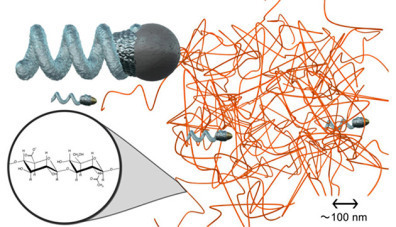 The scientific and medical research communities have been looking to develop robots that measure in the nanometer range (that’s one-billionth of a meter) for quite some time. Being so small, they would be able to perform difficult tasks, such as targeted drug delivery to specific cells, or the elimination of harmful antigens, pathogens or viruses. However, the development of such machines raises numerous challenges.
The scientific and medical research communities have been looking to develop robots that measure in the nanometer range (that’s one-billionth of a meter) for quite some time. Being so small, they would be able to perform difficult tasks, such as targeted drug delivery to specific cells, or the elimination of harmful antigens, pathogens or viruses. However, the development of such machines raises numerous challenges.
For one, making them small enough to fit between cells remains tricky, and these tiny bots would also need a propulsion system that will allow them to navigate their way through the human body. But now, in a paper published in the June 2014 issue of ACS Nano, an Israeli and German team announced the creation of the smallest nanobot yet, a magnet-guided corkscrew which is propelled by a tiny helical propeller.
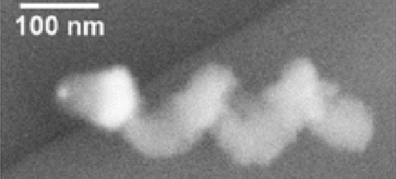 The team is comprised of researchers from the Technion-Israel Institute of Technology, the Max Planck Institute for Intelligent Systems, and the Institute for Physical Chemistry at the University of Stuttgart, Germany. Led by Dr. Peer Fischer at the Max Planck Institute, the research team created the tiny helical nanopropeller from a filament of silica and nickel that measures just 70 nanometers in diameter and 400 in length.
The team is comprised of researchers from the Technion-Israel Institute of Technology, the Max Planck Institute for Intelligent Systems, and the Institute for Physical Chemistry at the University of Stuttgart, Germany. Led by Dr. Peer Fischer at the Max Planck Institute, the research team created the tiny helical nanopropeller from a filament of silica and nickel that measures just 70 nanometers in diameter and 400 in length.
That’s more than 1,000 times smaller than the width of a human hair, or 100 times smaller than a single red blood cell, making the wee machine the tiniest nanopropeller humanity has ever created. Instead of carrying its own motor, the propeller is powered by an externally-applied weak rotating magnetic field which causes the prop to spin, driving it and its attached payload forward.
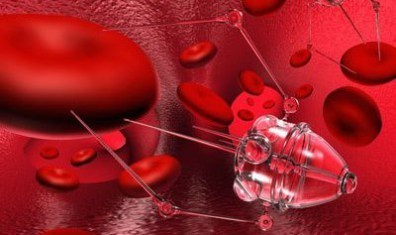 In order to test it, the scientist placed it in a hyaluronan gel, which is similar in consistency to bodily fluids. Like those fluids, the gel contains a mesh of entangled long polymer protein chains. In previous studies, larger micrometer-sized propellers got caught in these chains, slowing or completely halting their progress. The new nanoprop, however, was able to move relatively quickly by simply passing through the gaps in the mesh.
In order to test it, the scientist placed it in a hyaluronan gel, which is similar in consistency to bodily fluids. Like those fluids, the gel contains a mesh of entangled long polymer protein chains. In previous studies, larger micrometer-sized propellers got caught in these chains, slowing or completely halting their progress. The new nanoprop, however, was able to move relatively quickly by simply passing through the gaps in the mesh.
The study’s co-author, Associate Professor Alex Leshanksy of the Technion Faculty of Chemical Engineering, said that the nanobots:
actually display significantly enhanced propulsion velocities, exceeding the highest speeds measured in glycerin as compared with micro-propellers, which show very low or negligible propulsion.
The applications for this device certainly include targeted drug delivery, where the nanobots would be equipped with insulin, antibiotics, or even chemotherapy drugs which they could then deliver to specific cells in the body to speed up the delivery process and reduce side-effects. Scientists could also attach “active molecules” to the tips of the propellers, or use the propellers to deliver tiny doses of radiation.
 The applications seem wide, varied, and exciting, from combating diabetes to fighting cancer and HIV with surgical precision. And developments like these, though they measure in the billionth of meters, they add up to a future where lives are healthier, longer and more prosperous.
The applications seem wide, varied, and exciting, from combating diabetes to fighting cancer and HIV with surgical precision. And developments like these, though they measure in the billionth of meters, they add up to a future where lives are healthier, longer and more prosperous.
Sources: engadget.com, gizmag.com, ats.org


Sid Meier’s Civilization: Beyond Earth
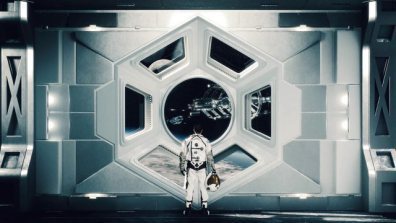 Sid Meier’s Civilization II is one of my favorite games of all time. I can’t tell you how many hours I spent playing this strategy game, even years after its release. The spinoff, Sid Meier’s Alpha Centauri, is another favorite that I still own. And despite them not being my favorites, Civ III, IV, and even V are all in my player chest. As a lifelong fan, I am usually pretty enthused when a new entry comes along.
Sid Meier’s Civilization II is one of my favorite games of all time. I can’t tell you how many hours I spent playing this strategy game, even years after its release. The spinoff, Sid Meier’s Alpha Centauri, is another favorite that I still own. And despite them not being my favorites, Civ III, IV, and even V are all in my player chest. As a lifelong fan, I am usually pretty enthused when a new entry comes along.
So when Beyond Earth was announced, I began paying attention. Similar to what Alpha Centauri did, the game follows an off-world expedition as it tries to establish a human settlement on a distant planet. As a victory condition in all the previous games, this sort of spinoff is a natural extension of the Civilization universe. Much like in the regular games, you establish settlements, research technologies, and compete with other factions for dominance.
 But what I especially like about these versions is the speculative nature of it all. As a future faction that is far removed from Earth, you have to deal with alien ecology and biology, research technologies that do not yet exist, unlock some of the fundamental mysteries of the universe, and even experience the technological and/or existential singularity. It’s way cool!
But what I especially like about these versions is the speculative nature of it all. As a future faction that is far removed from Earth, you have to deal with alien ecology and biology, research technologies that do not yet exist, unlock some of the fundamental mysteries of the universe, and even experience the technological and/or existential singularity. It’s way cool!
As the commercial description reads:
Sid Meier’s Civilization®: Beyond Earth™ is a new science-fiction-themed entry into the award-winning Civilization series. As part of an expedition sent to find a home beyond Earth, lead your people into a new frontier, explore and colonize an alien planet and create a new civilization in space. A New Beginning for Mankind is coming Fall/Autumn 2014.
According to Steam, the official release date is October 24th 2014. Check out the Announce Trailer below:


August 7, 2014
Remembering The Great War
 This past August 5th marks the centennial of the beginning of one of history’s greatest follies, otherwise known as World War I and the Great War. And all over the world, this anniversary is being marked in a number of ways. But in London, a particularly interesting display has been created by artist Paul Cummins and designer Tom Piper that gives new meaning to the term “swords into plowshares”.
This past August 5th marks the centennial of the beginning of one of history’s greatest follies, otherwise known as World War I and the Great War. And all over the world, this anniversary is being marked in a number of ways. But in London, a particularly interesting display has been created by artist Paul Cummins and designer Tom Piper that gives new meaning to the term “swords into plowshares”.
Using Tower of London, an institution that once represented oppression and imprisonment, the artists creatively arranged a series of red ceramic poppies – 888, 246 to precise. Each one represents a British soul who died during the war. Resembling blood pouring forth, the poppies extend from a window and then sweep into the Tower’s the moat, giving a visceral casualty-visualization to the extreme death toll.
 The last poppy will be “planted” November 11, the date WWI ended and the poppies will be available for purchase. As dreamed up by artist Paul Cummins and designer Tom Piper, the display – which is known as “Blood Swept Lands and Seas of Red” – was inspired by the words Cummings found in the will of a fallen solider. As he explained in an interview with The Guardian:
The last poppy will be “planted” November 11, the date WWI ended and the poppies will be available for purchase. As dreamed up by artist Paul Cummins and designer Tom Piper, the display – which is known as “Blood Swept Lands and Seas of Red” – was inspired by the words Cummings found in the will of a fallen solider. As he explained in an interview with The Guardian:
I don’t know his name or where he was buried or anything about him. But this line he wrote, when everyone he knew was dead and everywhere around him was covered in blood, jumped out at me: ‘The blood-swept lands and seas of red, where angels fear to tread.’
This latest display which attempts to visualize the costs of war in the same way “The Fallen” commemorated all those who fell at Arromanches Beach on D-Day. Created by British artists Jamie Wardley and Andy Moss, whose medium is most often sand, the artists and an army of 500 volunteers used rakes and stencils to create the silhouettes of the 9000 soldiers who fell on the beaches of Normandy on June 6th, 1944.
 As you can see from the aerial photograph above, the visualization drives home the terrible loss of human life in a way that cold statistics never can. This artistic display was made in honor of Peace Day last year, which has been held on Sept.21st of ever years since 1982. Having been to Arromanches this past April, I am sorry to say that I missed it. But such displays are short-lived, which only serves to add to their poignancy.
As you can see from the aerial photograph above, the visualization drives home the terrible loss of human life in a way that cold statistics never can. This artistic display was made in honor of Peace Day last year, which has been held on Sept.21st of ever years since 1982. Having been to Arromanches this past April, I am sorry to say that I missed it. But such displays are short-lived, which only serves to add to their poignancy.
This past June 6th was a time of sober reflection and commemoration as well. This year also marked the 70th anniversary since the Normandy invasion, and the occasion was not only a time to honor those who fell in what was arguably the most ambitious undertaking in history, it was also a time for world leaders to come together and show their commitment to peace.
 It has been a historic year, of that there is little doubt. And these two anniversaries are well-paired, drawing attention to two World Wars that were the most destructive in human history, but also inextricably linked. In total, some 90 million people died in both conflicts combined (thought estimates vary) and insisting that people remember how it all began is an opportunity to ensure that it never happens again.
It has been a historic year, of that there is little doubt. And these two anniversaries are well-paired, drawing attention to two World Wars that were the most destructive in human history, but also inextricably linked. In total, some 90 million people died in both conflicts combined (thought estimates vary) and insisting that people remember how it all began is an opportunity to ensure that it never happens again.
As said before, the last poppy will be planted on Nov.11th, 2014 to mark the end of the war. To purchase one of these, simply click here.
Sources: fastcocreate.com, (2), poppies.hrp.org.uk


August 6, 2014
An End to HIV: HIV Remove from Cultured Cells
 At the closing ceremony of the AIDS 2014 conference a few weeks ago in Melbourne, Australia, many of the speakers – including longtime AIDS researcher and International AIDS Society Presidential Award winner Eric Goosby – told of how utterly terrifying the disease seemed 30 years ago. And while that fear is not gone, it has since diminished, replaced by and large with a sense of hope that the disease will be eradicated.
At the closing ceremony of the AIDS 2014 conference a few weeks ago in Melbourne, Australia, many of the speakers – including longtime AIDS researcher and International AIDS Society Presidential Award winner Eric Goosby – told of how utterly terrifying the disease seemed 30 years ago. And while that fear is not gone, it has since diminished, replaced by and large with a sense of hope that the disease will be eradicated.
According to UNAIDS – the Joint United Nations Programme on HIV/AIDS, which is dedicated to destroying the disease by 2030 – the medical community has learned much in the past few years and stands a good chance at accomplishing this goal. And with new advances being announced every few months, hopes for a world in which this terrible disease no longer exists all seem firmly on track.
 Consider this latest development, which comes from the Temple University School of Medicine in Philadelphia. Here, researchers have discovered how to permanently extricate HIV-1 from human cells, effectively curing a patient of the disease. Combined with new vaccines that have shown the ability to block infection (and in some cases, even reverse it), this news may yet be reason for even greater hope.
Consider this latest development, which comes from the Temple University School of Medicine in Philadelphia. Here, researchers have discovered how to permanently extricate HIV-1 from human cells, effectively curing a patient of the disease. Combined with new vaccines that have shown the ability to block infection (and in some cases, even reverse it), this news may yet be reason for even greater hope.
One of the main issues in the treatment of HIV-1 is not simply that it is expensive, but that antiretroviral therapy have terrible side effects that can speed up diseases more commonly associated with aging or can cause co-infections, such as Hepatitis C, to become worse. Added to this is that HIV is a tricky and tenacious disease that becomes part of a patient’s DNA, making it virtually impossible to eradicate.
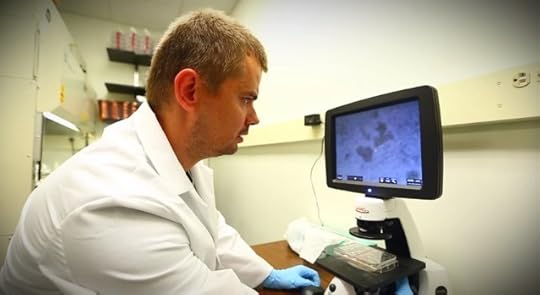 However, researchers from Temple University School of Medicine have found a way to cut the infected genes out, potentially eradicating the virus for good and negating the need for lifelong ARV treatment. The technique uses a DNA-snipping enzyme, a nuclease, and a targeting RNA strand to hunt down the genome and cuts the HIV-1 DNA from it. The cell is able to repair its own genomes, essentially sewing itself together again, only now HIV-free.
However, researchers from Temple University School of Medicine have found a way to cut the infected genes out, potentially eradicating the virus for good and negating the need for lifelong ARV treatment. The technique uses a DNA-snipping enzyme, a nuclease, and a targeting RNA strand to hunt down the genome and cuts the HIV-1 DNA from it. The cell is able to repair its own genomes, essentially sewing itself together again, only now HIV-free.
This treatment will work in varied cell types such as the T-cells and monocytic cells that harbor HIV. In designing the molecular tools, researchers chose nucleotide sequences that do not appear in any coding sequences of human DNA to avoid what they call off-target effects, where patient’s cells or own DNA might be damaged. The technique may also be applicable against many other viruses.
There are still serious hurdles, like how to get the treatment into each, individual cell. Also, HIV-1 is known for mutations, and every patient has their own viral sequence. This means that there can be no single, prescriptive treatment for it. However, another potential upside is that there is the chance this may be used not simply as a treatment but also a vaccine as cells containing the nuclease-RNA combination do not acquire the HIV infection.
 Dr. Kamel Khalili, Professor and Chair of the Department of Neuroscience at Temple, calls it an “important step” towards the eradication of AIDS, though it is still years away from the clinical stage. As he put it:
Dr. Kamel Khalili, Professor and Chair of the Department of Neuroscience at Temple, calls it an “important step” towards the eradication of AIDS, though it is still years away from the clinical stage. As he put it:
We want to eradicate every single copy of HIV-1 from the patient. That will cure AIDS. I think this technology is the way we can do it.
Though it is not the one-shot breakthrough many have been hoping for, this enzyme-based treatment is another step along the long road towards the end of HIV and another nail in its coffin. As long as treatments exist that are not only able to treat and block, but also fight the disease, there is much reason for hope.
And be sure to check out this video from Temple University, where Dr. Khalili explains the medical breakthrough:
Sources: gizmag.com, templehealth.org


August 5, 2014
News from Space: NASA Showcases New Rover Tools
 Last Thursday at the agency’s headquarters in Washington, NASA unveiled more information about its Mars 2020 rover, which is scheduled to join Opportunity and Curiosity on the Red Planet by the end of the decade. The subject of this latest press release was the rover’s payload, which will consist of seven carefully-selected instruments that will conduct unprecedented science and exploratory investigations, and cost about $130 million to develop.
Last Thursday at the agency’s headquarters in Washington, NASA unveiled more information about its Mars 2020 rover, which is scheduled to join Opportunity and Curiosity on the Red Planet by the end of the decade. The subject of this latest press release was the rover’s payload, which will consist of seven carefully-selected instruments that will conduct unprecedented science and exploratory investigations, and cost about $130 million to develop.
These instruments were selected from 58 proposals that were submitted back in January by researchers and engineers from all around the world. This is twice the usual number of proposals that NASA has received during instrument competitions in the recent past, and is a strong indicator of the extraordinary level of interest the scientific community is taking in the exploration of the Mars.
 These seven new instruments include:
These seven new instruments include:
Mars Oxygen ISRU Experiment (MOXIE): this technology package will process the Martian atmosphere into oxygen. ISRU stands for In Situ Resource Utilization.
Planetary Instrument for X-ray Lithochemistry (PIXL): this spectrometer will use a high-resolution imager and X-ray fluorescence for detailed elemental analysis to a finer degree than possible with any prior equipment.
Scanning Habitable Environments with Raman & Luminescence for Organics and Chemicals (SHERLOC): this sensor suite will use an ultraviolet laser for fine-scale mineralogy, detecting organic compounds, and high-resolution imaging.
Mastcam-Z: an advanced camera system that will send home panoramic and stereoscopic images and assist with rover operations and help determine surface mineralogy.
SuperCam: an imaging device with super capacities to perform chemical composition analysis and more mineralogy. This tool will allow the rover to peer around hunting for organic compounds within rocks or weathered soils from a distance, helping identify interesting locations to sample in greater detail.
Mars Environmental Dynamics Analyzer (MEDA): This sensor suite to measure temperature, wind speed and direction, pressure, and relative humidity. As dust is such a defining characteristic of weather on the red planet, it’s also going to measure dust size and shape, helping characterize how big of a hassle it will make housekeeping.
Radar Imager for Mars’ Subsurface Exploration (RIMFAX): a ground-penetrating radar to imagine the subsurface to centimeter-scale resolution.
These instruments will be used to determine how future human explorers could exploit natural resources to live on Mars, pinning down limits to how much we could rely on using local materials. In addition, demonstration technology will test out processing atmospheric carbon dioxide to produce oxygen, a key step towards using local resources for manufacturing oxidizers for rocket fuel and suitable for humans.
 This is perhaps the most exciting aspect of the proposed mission, which is looking ahead to the possibility of manned Martian exploration and even settlement. To quote William Gerstenmaier, the associate administrator for the Human Exploration and Operations Mission Directorate at NASA Headquarters in Washington:
This is perhaps the most exciting aspect of the proposed mission, which is looking ahead to the possibility of manned Martian exploration and even settlement. To quote William Gerstenmaier, the associate administrator for the Human Exploration and Operations Mission Directorate at NASA Headquarters in Washington:
Mars has resources needed to help sustain life, which can reduce the amount of supplies that human missions will need to carry. Better understanding the Martian dust and weather will be valuable data for planning human Mars missions. Testing ways to extract these resources and understand the environment will help make the pioneering of Mars feasible.
At the same time, and in keeping with plans for a manned mission, it will carry on in NASA’s long-term goal of unlocking Mars’ past and determining if life ever existed there. As John Grunsfeld, astronaut and associate administrator of NASA’s Science Mission Directorate in Washington, explained:
The Mars 2020 rover, with these new advanced scientific instruments, including those from our international partners, holds the promise to unlock more mysteries of Mars’ past as revealed in the geological record. This mission will further our search for life in the universe and also offer opportunities to advance new capabilities in exploration technology.
 NASA addressed these goals and more two weeks ago with their mission to Mars panel at the 2014 Comic-Con. This event, which featured retired astronaut and living legend Buzz Aldrin, spoke at length to a packed room about how Apollo 11 represented the “the first Giant Leap”. According to Aldrin, the Next Giant Leap could be “Apollo 45 landing humans on Mars.”
NASA addressed these goals and more two weeks ago with their mission to Mars panel at the 2014 Comic-Con. This event, which featured retired astronaut and living legend Buzz Aldrin, spoke at length to a packed room about how Apollo 11 represented the “the first Giant Leap”. According to Aldrin, the Next Giant Leap could be “Apollo 45 landing humans on Mars.”
The panel discussion also included enthusiastic support of Orion and the Space Launch System which are currently under development and will be used when it finally comes time to send human explorers to join the rovers on Mars. The Mars 2020 mission will be based on the design of the highly successful Mars Science Laboratory rover, Curiosity, which landed almost two years ago.
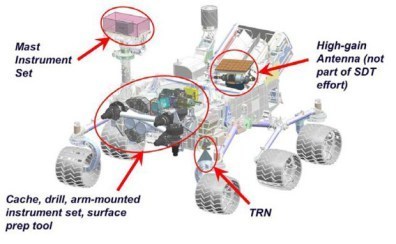 Not only does it look virtually identical to Curiosity – from its six-wheeled chassis, on-board laboratory, and instrument-studded retractable arms – and will even be partly built using Curiosity’s spare parts.It will also land on Mars using the same lowered-to-the-surface-by-a-giant-sky-crane method. NASA als0 plans to use the rover to identify and select a collection of rock and soil samples that will be stored for potential return to Earth by a future mission.
Not only does it look virtually identical to Curiosity – from its six-wheeled chassis, on-board laboratory, and instrument-studded retractable arms – and will even be partly built using Curiosity’s spare parts.It will also land on Mars using the same lowered-to-the-surface-by-a-giant-sky-crane method. NASA als0 plans to use the rover to identify and select a collection of rock and soil samples that will be stored for potential return to Earth by a future mission.
These rock samples will likely have to wait until the proposed manned mission of 2030 to be picked up, but NASA seems hopeful that such a mission is in the cards. In the meantime, NASA is waiting for their MAVEN orbiter to reach Mars and begin exploring it’s atmosphere (it is expected to arrive by September), while the InSight Lander – which will examine Mars’ interior geology – is slated for launch by March 2016.
 So we can expect a lot more news and revelations about the Red Planet in the coming months and years. Who knows? Maybe we may finally find evidence of organic molecules or microbial life there soon, a find which will prove once and for all that life exists on other planets within our Solar System. And if we’re really lucky, we might just find that it could feasibly support life once again…
So we can expect a lot more news and revelations about the Red Planet in the coming months and years. Who knows? Maybe we may finally find evidence of organic molecules or microbial life there soon, a find which will prove once and for all that life exists on other planets within our Solar System. And if we’re really lucky, we might just find that it could feasibly support life once again…
Sources: cbc.ca, fastcompany.com, nasa.gov, space.io9.com, (2), extremetech.com


August 4, 2014
Writing About Trauma
 Delving back into the world of Whiskey Delta, I’ve found myself coming back to a familiar theme for me that informs much of my writing. It’s the theme of trauma, how one experiences the feelings of being overwhelmed, depressed, anxious, and at a loss for control in their life. For those who follow the Whiskey Delta series, all of these are things that keep coming up for one main character – Sergeant Aaron Dezba.
Delving back into the world of Whiskey Delta, I’ve found myself coming back to a familiar theme for me that informs much of my writing. It’s the theme of trauma, how one experiences the feelings of being overwhelmed, depressed, anxious, and at a loss for control in their life. For those who follow the Whiskey Delta series, all of these are things that keep coming up for one main character – Sergeant Aaron Dezba.
In the story, Dezba is haunted by the loss of his wife and daughter – two people who became infected by the zombie virus and turned into living horrors. Unable to deal with it at first, he locked them in his basement and kept them alive, hoping that some kind of cure might be found someday. But upon learning that such a thing would never be possible, he killed them both and fell into a deep depression.
 As the story continued, he found a measure of redemption by confessing his crimes and rededicating himself to completing a mission that could possibly result in the creation of a vaccine. Though the virus could not be cured, the researchers in the story were able to fashion something that would immunize the uninfected against it. However, Dezba never forgot the loss of his wife and daughter, and remains haunted by this and similar traumas throughout the story.
As the story continued, he found a measure of redemption by confessing his crimes and rededicating himself to completing a mission that could possibly result in the creation of a vaccine. Though the virus could not be cured, the researchers in the story were able to fashion something that would immunize the uninfected against it. However, Dezba never forgot the loss of his wife and daughter, and remains haunted by this and similar traumas throughout the story.
In attempting to write about this, I actually drew a lot on my own experiences. It’s something I’ve never talked about in this forum, but thought that I might share it at this time. You see, a few years back, I was diagnosed with an anxiety disorder, and it was pretty obvious to the people I sought help from that it was caused by an extended period of high stress that I found myself in just previous to that.
 I’ve always been an OCD-type person; but apparently, enduring extreme stress can make the symptoms ten times worse, which pretty much describes my reality ever since! The short version is that during the fall/winter of 2007, I was working for three months in an isolated community, teaching grade 5/6 to a bunch of kids who hated my guts because I replaced their previous teacher.
I’ve always been an OCD-type person; but apparently, enduring extreme stress can make the symptoms ten times worse, which pretty much describes my reality ever since! The short version is that during the fall/winter of 2007, I was working for three months in an isolated community, teaching grade 5/6 to a bunch of kids who hated my guts because I replaced their previous teacher.
He, I say at the risk of editorializing, was a selfish prick who ran out on them because he was pissed about trivial disciplinary matters. And he took all the resources with him, leaving me with nothing. The first week, I got virtually no sleep and felt like I was on the verge of a nervous breakdown. I tried to quit, but couldn’t stomach the long-term consequences it would cause to my teaching career. No one else on the island was hiring, which meant I would have to find another career.
 What’s more, my father was absolutely livid when he found out I was hoping to quit, and I didn’t like the idea of being estranged from him. But mostly, I didn’t think I could live with the consequences of such a failure. And so, for the next three months, I stuck it out, committing to stay until someone permanent was found. And finally, at Christmas, they found my replacement, plus several more (more than a few people quit by this point in the year).
What’s more, my father was absolutely livid when he found out I was hoping to quit, and I didn’t like the idea of being estranged from him. But mostly, I didn’t think I could live with the consequences of such a failure. And so, for the next three months, I stuck it out, committing to stay until someone permanent was found. And finally, at Christmas, they found my replacement, plus several more (more than a few people quit by this point in the year).
I then returned home happy and relieved as all hell, but found that I still couldn’t sleep right and was feeling quite anxious all the time. Eventually, my mother suggested I might be depressed and recommended I go talk to someone. I did, and they diagnosed me with acute depression and anxiety. Things got better, without the need for drugs, but I found over the course of the next year that I could not return to what I considered to be normal.
 It was quite hard for me to hold down a regular job, and I absolutely needed regular sleep or I was just not the same. Eventually, I began to take meds and sought counseling until I thought I had a handle on things. Still, I was not too comfortable around my parents, my father and I had several strained conversations over how I felt he had made things worse, and when my wife and I moved in together, I was quite happy.
It was quite hard for me to hold down a regular job, and I absolutely needed regular sleep or I was just not the same. Eventually, I began to take meds and sought counseling until I thought I had a handle on things. Still, I was not too comfortable around my parents, my father and I had several strained conversations over how I felt he had made things worse, and when my wife and I moved in together, I was quite happy.
That too improved, but as soon as we left Comox to move to Victoria, I felt myself having problems again. I had stopped taking meds around this time, and being outside of my comfort zone made a big difference, I found. I once again sought out counseling, took a new kind of medication, and once again came through. I’ve been through many changes these past few years and things have gotten better, but the problem remains.
When serious stressors strike or something comes along that sets off my OCD, I suffer from acute anxiety, panic attacks and depression, and it usually takes a few days before it all finally goes away. I’ve come to learn so much from these episodes, like how one’s own mind can become their greatest enemy, just how much a person can endure, and how wonderful it feels coming out the other side.
 Every time, I manage to come through okay. But I always wonder, is this the way it’s going to be for the rest of my life? Will I be subject to severe bouts of OCD forever, or can I expect to be normal again? Well, normal for me, at any rate. These are the kinds of feelings and questions that I tap into whenever I need to write a character who has endured trauma and feels like he or she will never be the same again.
Every time, I manage to come through okay. But I always wonder, is this the way it’s going to be for the rest of my life? Will I be subject to severe bouts of OCD forever, or can I expect to be normal again? Well, normal for me, at any rate. These are the kinds of feelings and questions that I tap into whenever I need to write a character who has endured trauma and feels like he or she will never be the same again.
I explore these questions because it is something I now know. It is my private shame, and something I only share if I need to, or I choose to get really up close and personal. But writing is perhaps the most personal thing of all. And when I write, I choose to express my own experience with trauma as accurately and vividly as I can. It’s like a form of therapy, and I do believe it has made me a better writer.
As for the rest… Well, as the sayings go, life goes on. That which does not kill us, makes us stronger. And when life gives you lemons, make lemonade. And if you’re a writer, keep hammering those keys and turning your personal pain into art. Otherwise, what the hell good is it?






